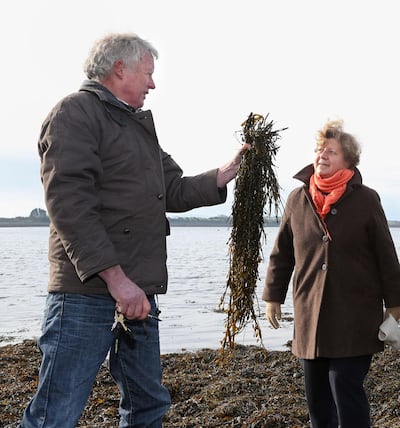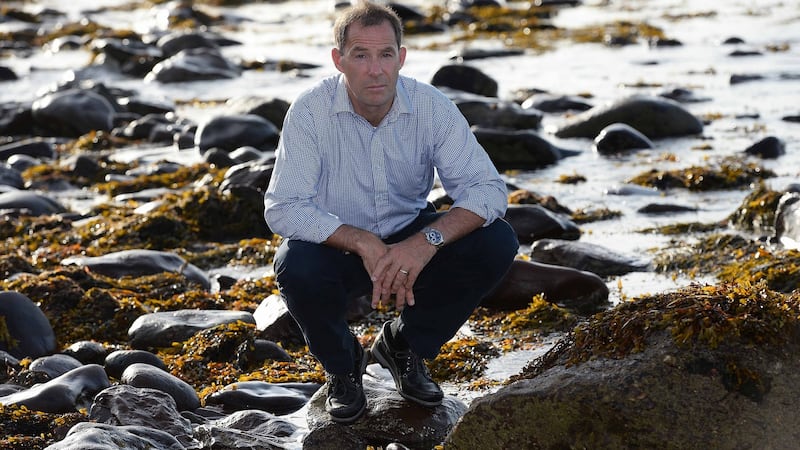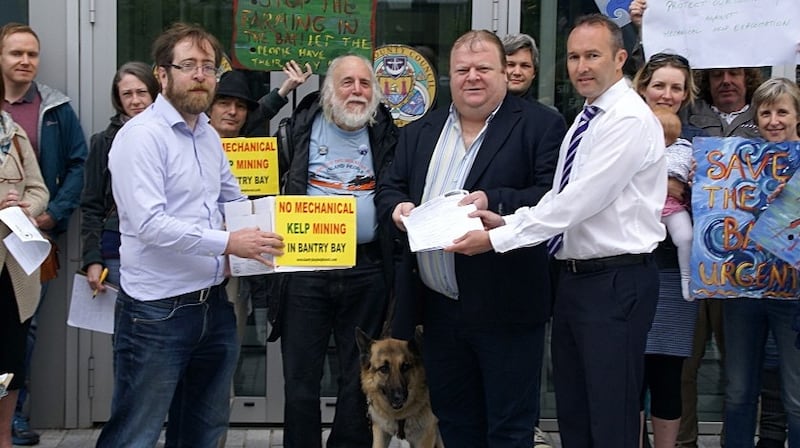Sea Thong. Cat’s Tail. True Sloke. Sting Winkle.
Confined to bed in a New York hospital some decades ago, a west of Ireland man busied himself with matching names to marine life on his home shore. His doctor allowed him to write a few of them down. Just three to four pages a day.
“As well as that, I would often be talking in my sleep,” Séamas Mac an Iomaire recalled. “I’d be back in Connemara, hauling pots or long-lines or nets or maybe even cursing the dogfish or the starfish . . . I would awaken suddenly . . . the noise and bustle of the city reminding me where I was.
“I would get so immersed in desirable memories that I would forget altogether that I was in a foreign country, lying on my back with TB . . .”
As a paean to the richness of coastal environments, it is hard to beat Mac an Iomaire's Cladaigh Chonamara or The Shores of Connemara, published in 1938. Written long before its least-appreciated fringe – seaweed – became a superfood and source of a multibillion euro global industry, the text bears all the enthusiasm of a David Attenborough documentary, and the fun of a Finding Nemo script, as it weaves in language and local knowledge with a facility that so many scientific tracts lack.
Ecologist Cillian Roden noted in his introduction to Pádraic de Bhaldraithe's translation that Mac an Iomaire dispels the "myth that the people of Ireland were a race of thalassophobes, incapable of observing their natural surroundings".
Mac an Iomaire’s generation was one that might lose more sleep over changing weather than a changing climate, but he would surely have appreciated the idea that feeding a small amount of dried seaweed to dairy cattle could reduce their methane emissions by as much as 99 per cent.
“I’m someone who spent the beginning of my life living on an island . . . listening to the perpetual lonely murmuring of the sea arriving continuously in big waves from the strange abyss in the west, breaking fiercely and bluntly against shore and beach,” Mac an Iomaire wrote.
“But even if the sea is like that, it’s from her that most of the people of Connemara make their living, and not by fishing alone but by making kelp. This is hard, bothersome work,” he acknowledged, as he gave character to the various types: mayweed, oarweed, sea rod, furbelows and more.
Hand-harvesting
John Bhaba Jeaic Ó Conghaile knows only too well about that "hard, bothersome work" as he holds up a croisín, a long piece of wood with a knife attached which was once a regular implement on his part of the coastline near Leitir Mealláin. Ó Conghaile is from that area of south Connemara known as the "islands", where hand-harvesting of seaweed is still a lucrative winter activity.
“We could cut the kelp here up until the 1960s, and we had all kinds of methods, including a smaller type of fork which would hook on to it and turn it . . . a bit like working spaghetti,” he says.
Ó Conghaile has an original copy of Mac an Iomaire’s work among his collection of several thousand books, and it records how kelp was burned in many areas for ash, used in soap-making, dyeing, paper, glass-making and bleaching linen. From 1820, the ash was also a source of iodine for medicinal and photographic use.
Ó Conghaile, who left school early to go fishing, grew up in the "alginate phase" when "an feamainn bhuí" (Ascophyllum nodosum), caught the eye of industry. It is one of some 600 seaweeds growing along the 7,800km Irish coastline, and its value is in its gelling agent, used in everything from ice-cream to the "heads" on beer to textile printing.

It became a source of raw material for State company Arramara Teo, founded in 1947. In the 1960s, the company built two factories, in Cill Chiaráin in Connemara and in Dungloe, Co Donegal, to handle dried weed. It was then shipped to Alginate Industries in Scotland, which held a 49 per cent share, while the government held 51 per cent.
Synthetic alginate
Employment grew through the 1970s to a seasonal high of 700, including harvesters, but development of a synthetic alginate put paid to much of this business. The Scottish shareholder reduced its involvement, and its stake was then bought by the State – which then transferred responsibility for Arramara from the Department of the Gaeltacht to Údarás na Gaeltachta in 2006.
This should have been a good move, given the experience gained by Údarás na Gaeltachta in aquaculture, and its remit to provide employment in peripheral Irish-speaking areas.
However, in 2007, a Canadian leader in the seaweed field, Acadian Seaplants, says it was "approached" by Údarás na Gaeltachta to purchase Arramara.
Founded over 30 years ago by Louis Deveau, Acadian Seaplants employs more than 300 people in eight countries and exports to more than 80 countries. Now run by Deveau's son Jean-Paul, it supplies seaweed-based products to the food, biochemical, agricultural and agri-chemical sectors, and cultivates crop for the Asian and global food markets.
The sale was agreed and given ministerial approval, with minister of State for Gaeltacht affairs Dinny McGinley confirming it in 2014. Acadian promised an initial investment of €2 million, and a promise of more in research and development. The actual price paid is the subject of 10-year confidentiality clause. It came as a shock to hand-harvesters, and to a growing domestic industry depending on Arramara as a source of raw material.
Freedom of Information documents subsequently showed Enterprise Ireland had expressed concern. Bord Iascaigh Mhara, the State's sea fisheries board, wasn't consulted at all , but says its remit in seaweed relates to "farming", rather than wild harvesting.
Concern
Kerryman John T O'Sullivan was also concerned. O'Sullivan is managing director of BioAtlantis, a Tralee-based company which patented extraction of two key bioactive ingredients from kelp for use in antibiotic treatment of animals. In 2008, his company applied for a foreshore licence to harvest kelp, initially in Kenmare Bay. It was advised that this was a sensitive habitat, and so it reapplied for Bantry Bay.
O'Sullivan expressed his disappointment over the handling of the State sale of Arramara to an Oireachtas committee on environment, culture and the Gaeltacht in July 2014. He described how his company only latterly became aware of the opportunity, and was given just 12 days to prepare a bid of €5.7 million. He claimed that two foreign companies – Acadian Seaplants and French company Setalg – had been given more than a year to prepare their bids, and both were far less than his. The lack of transparency was "frightening" in relation to the final sale, he said.

Acadian hired two former Údarás executives associated with Arramara – Dónall Mac Giolla Bhríde, who was running Arramara's Cill Chiaráin plant before the sale, and Jim Keogh, formerly Údarás enterprise and employment manager who was part of a senior executive team that was involved in managing the sale to Acadian. Keogh told The Irish Times last year that he saw no conflict and passionately believed in the potential of seaweed and aquaculture for coastal communities.
The local response, initially muted, became more heated when word went around that Arramara had departed from the established practice of relying on the harvesters for the raw material. Instead it had lodged a direct application with the Department of Environment – now Housing and Local Government – to hold licences along some 20 per cent of the coastline between Clare and north Mayo.
Coincidentally, the department confirmed in 2014 that a review of seaweed-harvesting licensing was in train in the context of amending and updating the 1933 Foreshore Act.
‘Resource grab’
Acadian’s chief executive Jean-Paul Deveau confirmed he had met government officials as far back as 2007 in relation to “licensing, the regulatory framework, and the process by which one could apply for a licence”. However, he denied that purchase was dependent on securing harvesting rights.
BioAtlantis described Acadian/Arramara’s move as a “resource grab”. John Bhaba Jeaic Ó Conghaile and a group known as Cearta Feamainne Chonamara (the Connemara seashore and seaweed rights committee), expressed fears about potential “privatisation” of access to the material, and the impact on communities like his.
“If they get the licenses for this large stretch of coastline, they don’t need us hand-harvesters, and they will want to mechanise harvesting,” Ó Conghaile explained. Mechanisation, using boats, would allow the company to take advantage of the tide – hand-harvesting requires low tides – but with possible adverse environmental impacts.
As harvester Johnaí “Dubh” Clochartaigh from Maínis explains, the “feamainn bhuí” requires careful handling with his knife. That knife must not cut the holdfast or root on the rock, as this allows the weed to grow back in the saltwater and sunlight. It takes about five years to return to full harvestable length.
“We mark our patches with rocks as we work in low tide,”he says. “If you have a boat in here harvesting, it needs the tide, it won’t see the patches, and it will cause awful conflict.”
The big dilemma, as he observes, is the fact that a younger generation doesn’t want to engage in the sort of back-straining toil he loves.
Sure enough, last autumn, several craft appeared, and at least one was sighted working on seaweed near Roundstone. The Department of Housing and Local Government had not been informed. It has since confirmed that it was advised that some trial harvesting using the boat and rake method was being carried out.
“Upon making enquires, the department was advised that the harvesting, carried out by a couple of local men, had ceased,” it says.
Arramara’s license applications for the Clare to Mayo coast are effectively “on hold” until legal advice is received from the Attorney General, the department says. It describes it as a “very complex legal issue around the implications of the interaction between existing seaweed harvesting rights and the applications for licences”.
Bantry move
Down south, however, there are further stirrings – this time involving John T O’Sullivan himself. In 2014, his company, BioAtlantis, received its long-awaited foreshore licence for kelp. The permit approves use of a 21-metre boat for “mechanical” harvesting on a trial basis over 10 years.
A petition with 7,000 signatures has been submitted to Minister for Local Government Eoghan Murphy, objecting to the lack of public consultation, while Independent TD for Cork South-West Michael Collins has called on Murphy to revoke the license. Green Party senator Grace O'Sullivan has urged a "pause" which would allow the minister and BioAtlantis to agree to a voluntary environmental impact assessment.
“This licence is for 1,860 acres, which is a massive amount of sea, and it will have adverse impacts on the habitat for sea life within the kelp forests,” Collins contends.
The “Bantry Bay – Protect Our Native Kelp Forest” group, which collected the petition, fears that the mechanical harvesting may cause “irreversible damage to the ecosystem and businesses of the Bantry Bay area”, and will have a very negative impact on the “50-plus inshore fishermen who rely on Bantry Bay to make a living”.
The group is very concerned about the manner in which public consultation was conducted – just one advertisement in the Southern Star, it says – and lack of an environmental impact assessment. It believes this could be in breach of a number of EU directives, and against the spirit of the Aarhus Convention on access to environmental information which Ireland is party to.

Kelp forests are a nursery for juvenile fish and crustaceans, such as crab and lobster, the group's spokeswoman Deirdre Fitzgerald points out. They provide spawning grounds for many species of fish, and form the "base of the food web in Bantry Bay". They "slow wave action", limiting coastal erosion, and are "an important carbon store", she says.
Shipwrecks
She points to research undertaken for the group,which says there is evidence of at least 17 shipwrecks within or close to the areas licensed to BioAtlantis for mechanical harvesting – only three of which are recorded on the Shipwreck Inventory of Ireland.
“Our argument is not with BioAtlantis, but with the State for the manner in which this was carried out,” Fitzgerald says.
BioAtlantis points out that kelp has been mechanically harvested in France and Norway since the early 1970s, and the system it is adopting "differs fundamentally . . . we don't touch the seabed." O'Sullivan says the company will not be using the French scoubidou method or the Norwegian kelp dredge, but will use a mower suspended from the boat which "will not cut below 25cm or 12 inches".
“ This will allow us to cut the older weed, allowing younger plants to flourish as they will have more access to sunlight,” he says. “Every peer-reviewed scientific study shows that kelp recovers within three to six years after harvesting.”
BioAtlantis says it consulted eight public bodies, including the Underwater Archaeology Unit and National Parks and Wildlife Service, as part of its foreshore licence application. The Marine Institute is in favour of an indigenous seaweed sector, once it takes place in a "safe and controlled manner".
BioAtlantis commissioned a baseline study from University College Dublin and MERC Environmental Consultants in September 2016, which is awaiting departmental approval. Once signed off, it will be published and work can begin, the company says.
Pilot project
Ironically, Bantry Bay was the focus of a pilot project to allow for a more inclusive approach to managing the State's foreshore. "Information and transparency" and "public participation" were key tenets of the Bantry Bay Charter, pioneered by Cork County Council and partners, including University College Cork, and published in 2000 as an EU LIFE project for coastal zone management.
Fitzgerald’s opposition group acknowledges that BioAtlantis was only following the letter of the law. A new “streamlined” Maritime Area and Foreshore (Amendment) Bill has been on the “A” list of priority legislation for several years. It gives new powers to An Bord Pleanála and coastal local authorities, and also gives Ministers power to exempt certain developments. Driven by the EU’s “blue growth” strategy, it does incorporate environmental impact assessments, but not in all circumstances.
Coastwatch Europe co-ordinator Karin Dubsky says the Bill has "potential" to incorporate the best elements of coastal zone management, marine spatial planning and harvesting from the wild, including seaweed, but it "must be transparent". It is all the more urgent, given that Brexit poses shared marine management problems in Carlingford and Foyle loughs, she says.
“Seaweed as a product has really taken off, prices have jumped, but there is no policy and no fair legal system,”she says. “Scotland is really ahead of us on this, and has published a well-balanced policy. That could be a model for us.”
Seaweed harvesting licences: State’s system requires urgent reform
Marine Scotland, the government body charged with managing Scotand's seas, says that artisanal hand cutting or picking wild seaweed has far less environmental impact than mechanised harvesting.
A strategic environmental assessment (SEA) published by late last year noted that there is always a risk that the "small" green and red seaweeds could be cleared from an area by small-scale harvesting, but it says that mechanised harvesting of kelps and wracks could have "significant adverse effects".
"Seaweeds and seagrasses play a key role in marine and coastal ecosystems,"its SEA notes, and some species modify their environment and support high levels of marine and coastal biodiversity as "ecosystem engineers".
"As primary producers, they are also critical for supporting food webs which in turn contribute to fish and shellfish productivity,"the report says.
If rising demand for seaweed is best met here, then, by a combination of closely monitored harvesting and seaweed farming, the State's licensing system will require urgent reform.
There are currently six licensed aquaculture “grow-out” sites, including Cork’s Bantry and Roaringwater Bay, Ventry in Co Kerry and Clew Bay, Co Mayo, and 23 applications for more seaweed cultivation sites.
NUI Galway’s Martin Ryan Institute and Bord Iascaigh Mhara (BIM) have both highlighted more potential. BIM’s new Environmental Sustainability Atlas is reporting success with culture techniques for several species, including Atlantic wakame (Alaria esculenta) and Kombu (Saccharina latissimi), while it says the “red” varieties, Dulse (Palmaria palmata) and Nori (Porphyra), are “more technically challenging”.
However, developers face the same challenges as fish farmers caught in a system beset by severe bureaucratic delays which can transcend environmental concerns.
Minister for Marine Michael Creed has recently received an Independent Aquaculture Licensing Review group report which is scathing of the current system, including the fact that up to 17 different agencies are involved, and his response is awaited with much bated Atlantic breath…











